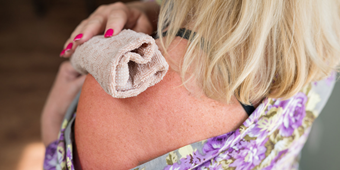Cellulitis: A More Than Skin-Deep Problem

Answer a few questions and we'll provide you with a list of primary care providers that best fit your needs.
Cellulitis is a bacterial infection of the deep layers of your skin and the tissue beneath your skin. Although it’s common in adults and children,
Without treatment the infection can spread quickly and permanently damage your immune system.
How Can You Get Cellulitis?
A cellulitis infection can occur anywhere you have a break in your skin. It can develop after surgery; after getting a tattoo or piercing; after a cut, bite, or scrape; or following breakouts of conditions like eczema, psoriasis, or athlete’s foot.
Typically, strep or staph bacteria gets into your body through a break in your skin. It’s possible to get infected without even realizing you had a break in your skin.
What Does Cellulitis Look Like?
The infection causes your skin to turn red, swollen, tender, and warm. Your skin may look glossy or stretched.
Kids usually get cellulitis on their face, neck, or around the anus. Adults usually get it on a lower leg, face, or arm. But it can show up anywhere. One way to recognize cellulitis is that it typically shows up in only one spot. If you have a condition that appears in both of your lower legs, it’s probably not cellulitis.
If your infection becomes severe, you may develop blisters, pus-filled bumps, or open sores. Your lymph nodes may feel swollen. Severe cellulitis can quicken your heart rate, lower your blood pressure, and make it difficult for you to concentrate. And severe cellulitis can be very painful.
What Raises Your Risk Of Getting Cellulitis?
Anyone can get cellulitis. But your risk is higher if you:
- Have diabetes, especially if it is poorly controlled
- Are middle-aged or older
- Are overweight or obese
- Use intravenous drugs
- Frequently injure your skin. Athletes, children, and anyone who frequently falls are more susceptible.
- Have a condition that weakens your immune system
How Is Cellulitis Treated?
 If caught early, cellulitis can be treated with an antibiotic taken by the mouth for one or two weeks. If you have a weakened immune system you may need to take it longer. To make sure all the bacteria is destroyed, it’s important that you take your medication until it is gone.
If caught early, cellulitis can be treated with an antibiotic taken by the mouth for one or two weeks. If you have a weakened immune system you may need to take it longer. To make sure all the bacteria is destroyed, it’s important that you take your medication until it is gone.
If your cellulitis is painful, you may also need pain medication. When caught and treated early, you should notice improvement within a day or two.
If not caught early, your infection can spread quickly. It can travel to your lymph nodes and into your blood stream. In this case you likely will be hospitalized in order to take antibiotic medication intravenously (IV) in your arm.
Bandages will be used to keep your wound clean and quicken the healing.
How Can You Prevent Getting Cellulitis Again?
If you’ve had cellulitis, you have a higher chance of getting it again. Most people get cellulitis in the same place every time. Follow these steps to decrease your chance of a recurrence:
- Protect your skin by wearing gloves when gardening, keeping your nails trimmed, wearing sunscreen, and using moisturizer to keep your skin from cracking.
- Treat skin wounds right away. Wash them with soap and water, apply antibiotic ointment, and cover with a bandage.
- Lymphedema increases your chances of cellulitis more than any other medical condition. Work with your doctor to manage your lymphedema and other conditions like diabetes, eczema, leg ulcers, and peripheral artery disease.
If you continue to get flare-ups of cellulitis, your doctor may prescribe a continuous low-dose antibiotic.
Answer a few questions and we'll provide you with a list of primary care providers that best fit your needs.
Source: American Academy of Dermatology; American Academy of Family Physicians; Cellulitis, Healthwise, 4/1/2019




